Welcome to our article dedicated to exploring the diverse range of fruit trees that grow in Ohio. From classic favorites like apple and cherry trees to lesser-known varieties, join us as we unveil 18 delightful options for cultivating your own fruitful backyard oasis.
Gardening Climate in Ohio
Ohio is a great place for gardeners! With a humid continental climate, Ohio offers a variety of growing opportunities. The USDA Hardiness Zones for Ohio range from Zone 5a in the northwest to Zone 6b in the south. Gardeners in Ohio can expect to enjoy a variety of plants, including trees, shrubs, flowers, and vegetables.
Though Ohio offers ideal conditions for gardening, gardeners must be aware of some of the unique challenges they may face. As the weather is unpredictable, Ohio gardeners must be prepared for late frosts, high winds, and extreme temperatures. Additionally, gardeners must be careful to protect their plants from pests and deer.
To ensure success, Ohio gardeners should research the plants they are considering before planting. This will help them to choose varieties that are suited for their hardiness zone, as well as the specific challenges of Ohio gardening. Additionally, many Ohio gardeners choose to build raised beds and use coverings to protect their plants from late frosts. With a little bit of preparation, Ohio gardeners can enjoy a successful and fruitful gardening experience.
18 Fruit Trees That Grow in Ohio
With proper winter protection when they are young, you can grow many different fruit trees in Ohio. If you only have a small amount of space, consider growing fruit trees in containers.
1. Apple
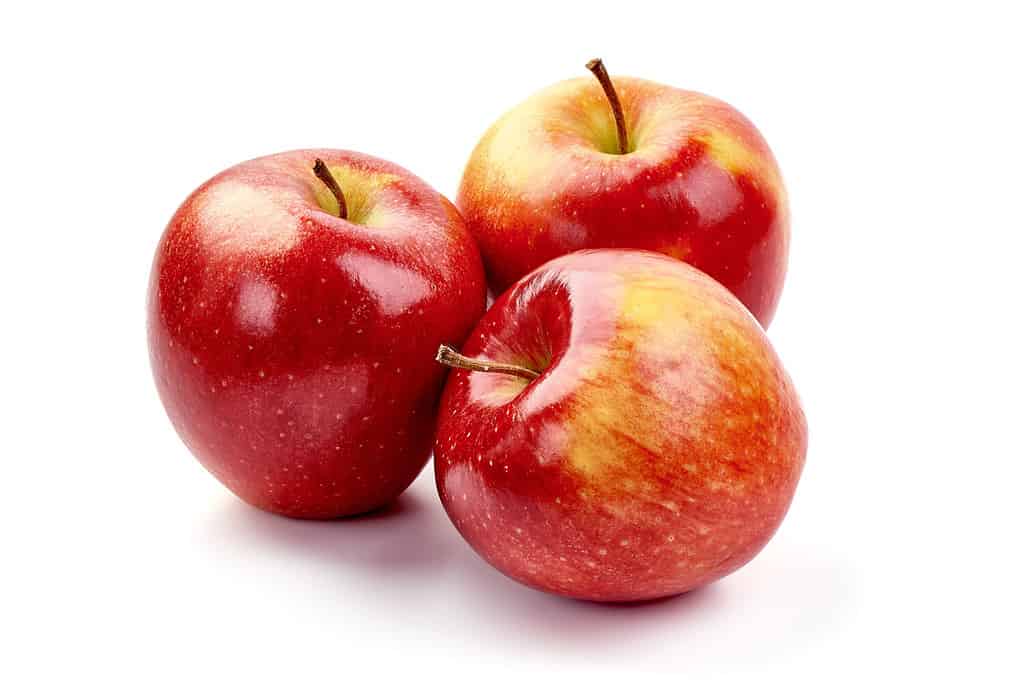
Apples are tasty fruit trees that grow in Ohio.
©GSDesign/Shutterstock.com
Ohio is a great place to grow apple trees! To get started, make sure to select the right cultivar for your climate. For Zone 4a, recommended cultivars include Liberty, Empire, and Honeycrisp. For Zone 4b, Gala and Red Delicious are popular choices. If you live in Zone 5a, try Golden Delicious, Idared, or Melrose. Zone 5b cultivars include Rome, Northern Spy, and Jonathan. In Zone 6a, Fuji and Granny Smith are recommended, and Zone 6b is well suited to Braeburn and Golden Supreme.
When planting, make sure to choose a spot with full sun and good drainage. Dig a hole that is twice as wide and just as deep as the root ball. Add a handful of fertilizer to the bottom of the hole and mix it with the soil. Place the root ball in the hole, and fill it with soil. Water the tree and mulch around the base.
For the first few years, prune the tree to encourage growth and protect it from disease. Once established, fertilize the tree in early spring and water regularly. With the right care, your apple tree will bear delicious fruit in no time!
2. Apricot
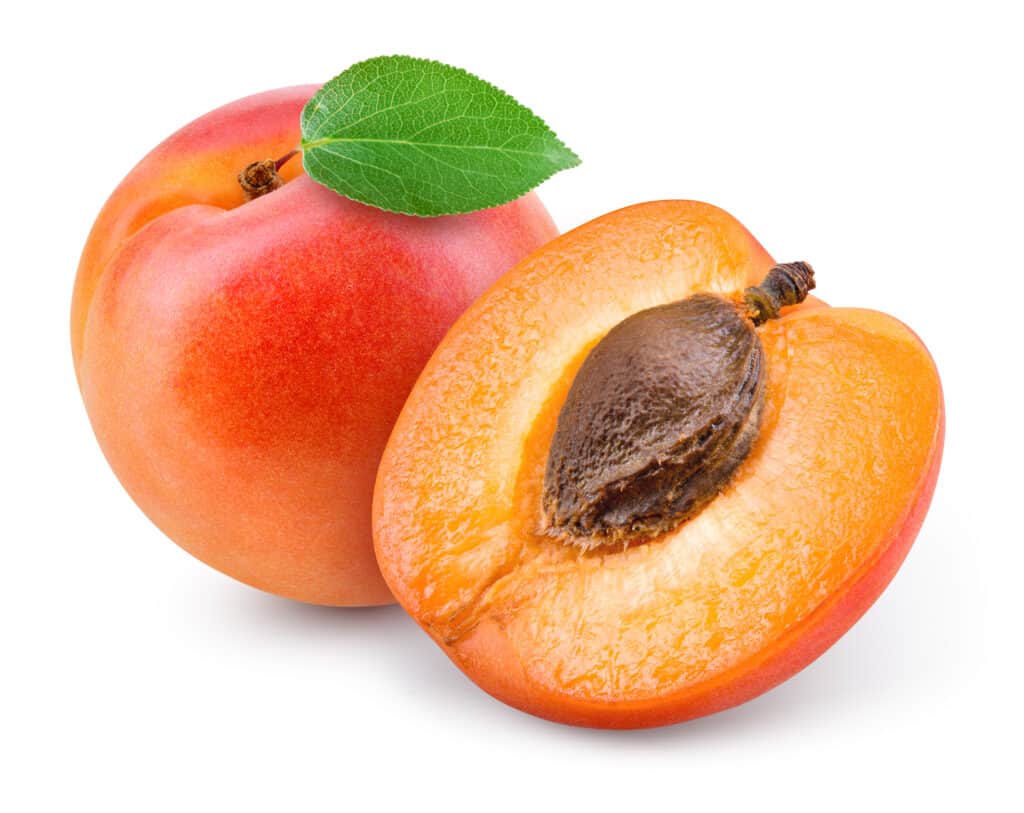
The apricot fruit is loaded with vitamins.
©Tim UR/Shutterstock.com
Apricot trees can be successfully grown in Ohio with the right cultivar and proper planting and care. Recommended cultivars for Ohio include the Harglow and Gholdric, both of which are hardy in USDA zones 5-7.
To plant an apricot tree, choose a location in full sun with well-drained soil. Dig a hole twice as wide and slightly deeper than the root ball. Add 2 to 3 inches of compost to the soil removed from the hole and mix in. Place the tree in the hole and fill it in with the amended soil. Water the tree thoroughly and mulch around the base with two to three inches of organic mulch.
Fertilize the tree in late winter or early spring with a balanced fertilizer such as 10-10-10 or 5-5-5. Prune the tree in late winter or early spring to remove dead, diseased, or crossing branches and to maintain an open canopy.
Apricot trees require regular watering. During the summer, the tree should receive 1–2 inches of water per week. In winter, water the tree whenever the soil around the tree is dry. With proper care, apricots are fruit trees that grow in Ohio and will bear delicious fruit in late summer.
3. Cherry
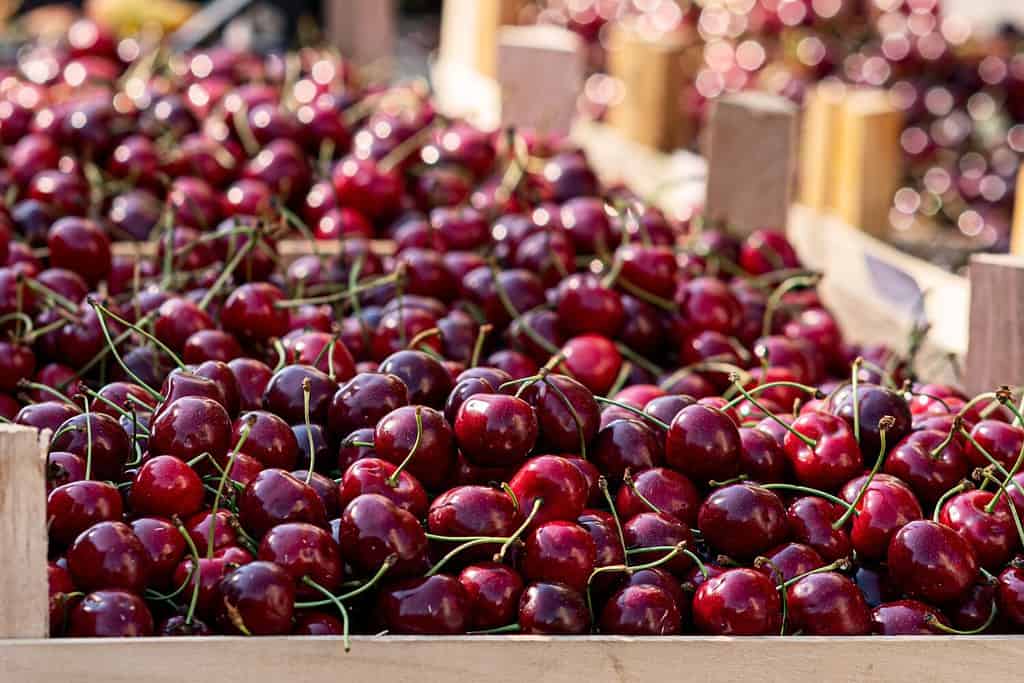
You can grow cherries in Ohio.
©Andrey Mihaylov/Shutterstock.com
Cherries are great fruit trees that grow in Ohio. There are several cultivars that are well-suited to the region, depending on the hardiness zone.
- For hardiness zone 5, the Early Richmond and North Star are excellent choices. These sweet cherries are self-pollinating and mature early in the season.
- In hardiness zone 6, Montmorency and Meteor are good options. Both of these tart cherries are self-pollinating and produce abundant fruit.
- For hardiness zone 7, Stella and Rainier are recommended. Both of these sweet cherries are self-pollinating and have excellent flavor.
When planting cherry trees, choose a sunny location and well-drained soil. Dig a hole that is twice as wide as the root ball and add some compost or manure to the soil. Water the tree deeply after planting and mulch around the base. Prune the tree to promote growth and maintain shape.
Cherry trees need regular watering and fertilizing to produce healthy fruit. Water the tree during dry spells and fertilize in the early spring. Monitor the tree for pests and diseases and take appropriate action.
4. Peach
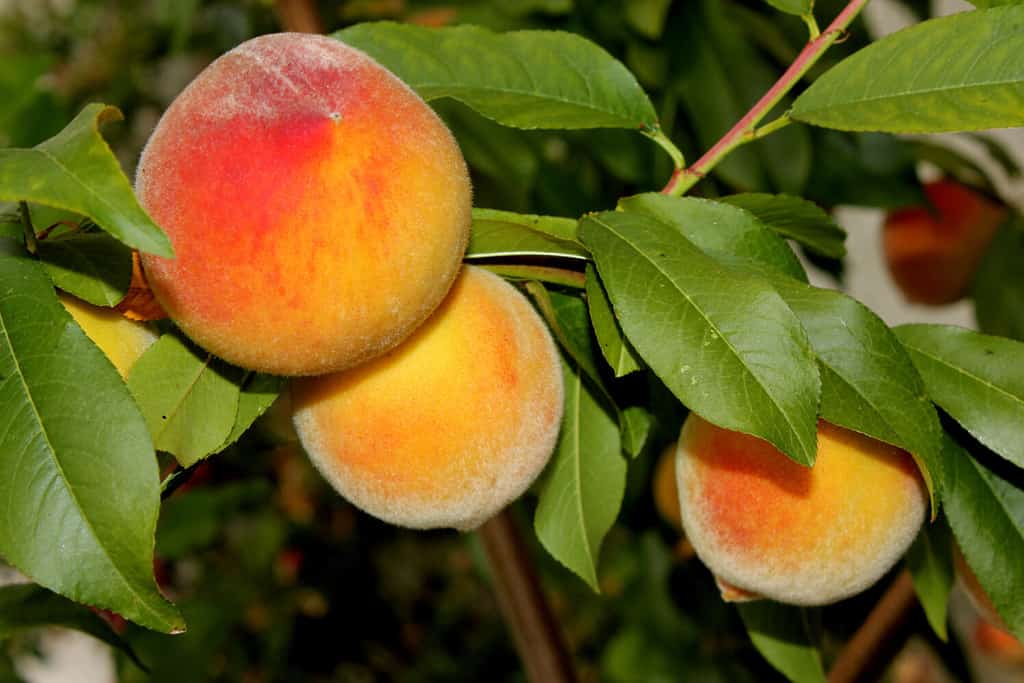
Nothing is more rewarding than growing your own peaches.
©Gurcharan Singh/Shutterstock.com
If you’re looking to grow peach trees in Ohio, there are several cultivars that are recommended for the region. These include Redhaven, Elberta, and Harrow Diamond, which are all hardy in USDA Hardiness Zones 5-8.
When planting your peach tree, choose a spot that gets full sun and has well-draining soil. Dig a hole two to three times as wide as the root ball and the same depth. Place the tree in the hole, and backfill it with soil, gently packing it down as you go. Provide the tree with 1-2 inches of water a week during the first year of growth.
It’s also important to prune your tree to maintain its shape and health. In the first year, prune off any dead or diseased branches, as well as any that cross over each other. In the second and subsequent years, prune away branches that are growing close to the center of the tree.
Finally, fertilize your peach tree once a year in the late winter or early spring. Use a fertilizer that’s specifically designed for fruit trees, and follow the instructions on the label for application. With these tips, you should be well on your way to growing healthy and delicious peaches in Ohio.
5. Pear

Many pear trees are cold-hardy.
©Pe3k/Shutterstock.com
If you’re looking to add some fruit-bearing trees to your Ohio garden, consider growing pear trees. There are several cultivars recommended for Ohio, each with its own hardiness zone.
- Bartlett (Zone 5): This is one of the most popular pear varieties and grows well in Ohio.
- Harrow Delight (Zone 5): This cultivar is a large, yellow-skinned pear with a sweet flavor.
- Orient (Zone 5): This variety produces attractive, medium-sized yellow fruit with a sweet flavor.
- Magness (Zone 5): This is an early-ripening, sweet pear with attractive yellow skin.
When planting your pear tree, choose a spot with good air circulation and plenty of sunlight. Plant in well-drained soil and water regularly during the growing season. Prune and thin your tree as needed to promote healthy growth and fruit production. Fertilize twice a year with a balanced fertilizer to ensure your tree will produce plenty of pears.
6. Plum
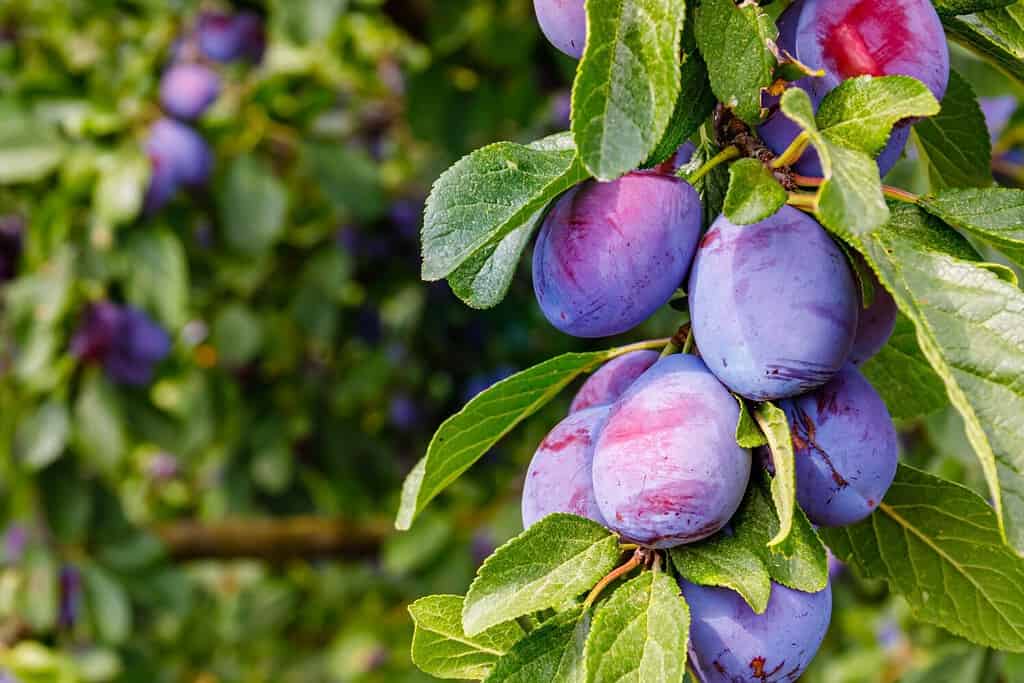
The dwarf plum trees will provide a full crop of fruit in a more compact size.
©nnattalli/Shutterstock.com
If you’re looking to grow plum trees in Ohio, you’ll need to consider the hardiness zone and recommended cultivars. Ohio has a wide range of climates, so you’ll need to choose cultivars that are suited for your specific zone.
Here are a few cultivars that are commonly grown in Ohio:
- Zone 5b: Methley, Santa Rosa, Stanley, and Superior
- Zone 6a: Shiro, Methley, Santa Rosa, and Superior
- Zone 6b: Shiro, Methley, Santa Rosa, Stanley, Superior, and Vivid
When planting plum trees, it’s important to choose a spot with good drainage and full sunlight. The soil should be amended with organic matter, and the tree should be properly watered and fertilized. Prune the tree during the winter months to ensure a healthy and robust tree. With proper care and attention, you should be able to enjoy delicious plums from your tree.
7. Nectarine
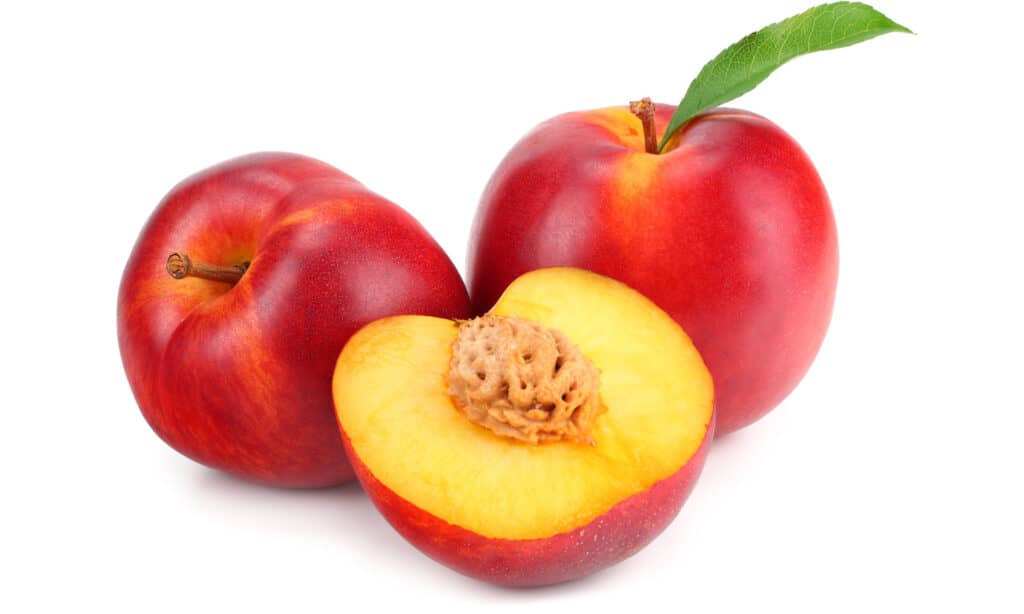
Fresh nectarines are safe and nutritious for dogs as long as they are prepared and served correctly.
©iStock.com/Dmytro
Ohio gardeners can successfully grow nectarine trees in their gardens. The key is to select cultivars that are recommended for Ohio and that are suitable for Ohio’s hardiness zones.
The most widely recommended nectarine cultivars for Ohio are ‘Red Gold,’ ‘Fantasia,’ ‘Harbelle,’ ‘Harken,’ and ‘Suncrest.’ These cultivars are suitable for hardiness zones 5 and 6.
When planting nectarine trees in Ohio, choose a sunny location with well-drained soil. Plant in the early spring or late fall. Dig a hole that’s twice as wide and just as deep as the root ball. Place the tree in the hole and backfill it with soil, tamping it down gently.
Water the tree deeply once a week during the growing season. Prune the tree to encourage healthy branching and maintain a desirable shape. In the late winter or early spring, apply a fertilizer that’s specifically formulated for fruit trees.
8. Fig

If you live in Zone 6, you can grow figs in Ohio.
©Eric Buermeyer/Shutterstock.com
Fig trees are a great addition to any Ohio garden. To maximize success, choose one of the following cultivars.
The Celeste and Brown Turkey cultivars grow well in Ohio. Both are hardy in USDA Zones 6-9. The Celeste fig is a small tree with an upright form, while the Brown Turkey fig is larger, reaching up to 20 feet tall and wide.
To grow a fig tree in Ohio, start with a 2-3 foot tall container-grown plant. Plant it in well-drained soil in a sunny location. Mulch around the tree to keep the soil moist and warm.
Water the tree regularly during the first growing season until it grows deep roots. After the first season, water when the soil is dry to the touch.
Fertilize in early spring with a nitrogen-rich fertilizer. Prune the tree to maintain its size and shape and to promote fruit production.
9. Mulberry
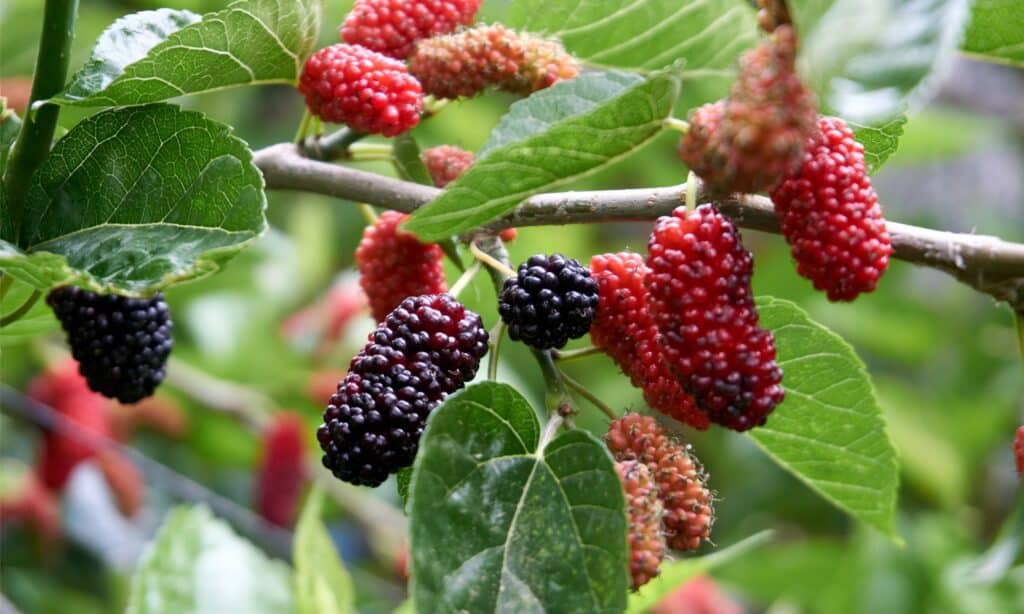
Don’t plant mulberry trees anywhere near your car or parking spaces.
©iStock.com/altanakin
Mulberry trees are a great addition to any Ohio garden. To successfully grow mulberry trees, there are a few key steps to take.
First, choose a cultivar that is recommended for Ohio and is suited to your hardiness zone. Popular cultivars include ‘Illinois Everbearing’ (hardiness zone 5-8) and ‘Shatoot’ (hardiness zone 5-9).
Once you have chosen your cultivar, ensure the soil is well-draining and slightly acidic. Plant your tree in the spring and fertilize it with an organic fertilizer. Mulberry trees are hardy and can tolerate drought conditions, but regular watering is important to ensure a healthy tree.
Prune your mulberry tree in the winter to remove any dead wood or branches. Pruning will also help to encourage a bushier tree. For best results, mulberry trees should be planted in an area that receives full sun.
10. Walnut
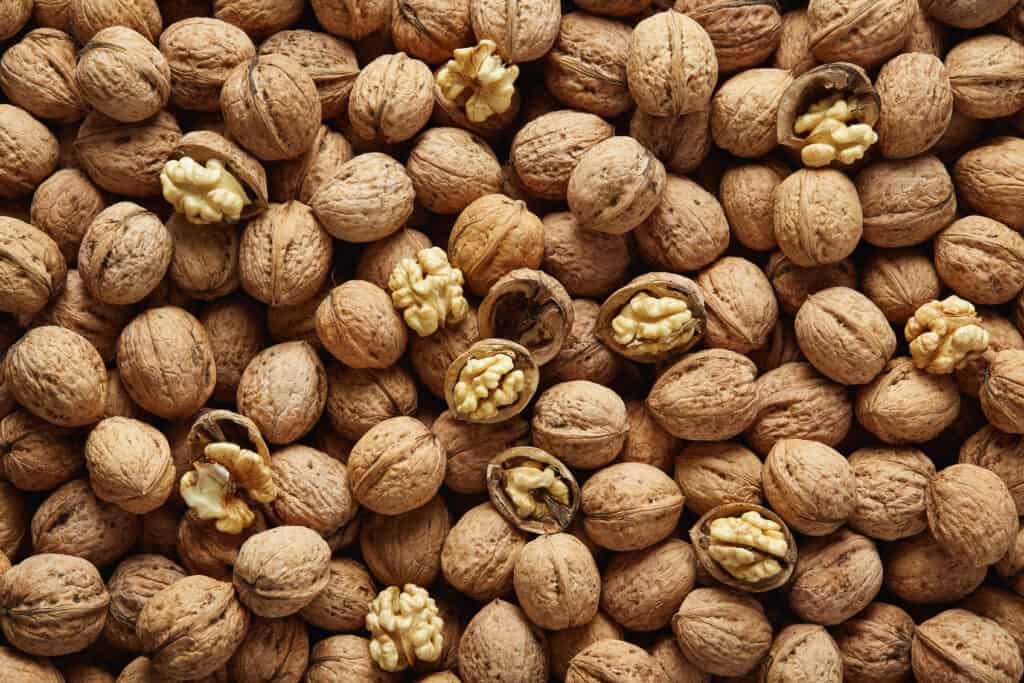
Walnuts are high in protein and vitamins.
©Melica/Shutterstock.com
Growing walnut trees in Ohio is relatively easy. The cultivars recommended for Ohio vary according to the hardiness zone in which you are gardening. The following cultivars are recommended for Ohio.
- Carpathian English walnut
- Black walnut
- Hartley walnut
- Persian walnut
Once you’ve chosen the right cultivar, you need to find a location with plenty of sunlight and good drainage. Plant your walnut tree in well-worked soil, at least two feet deep. Water your trees regularly, especially during the first few weeks after planting. Lastly, fertilize your walnut tree in the spring to ensure its health and growth. With the right care and attention, you can expect your walnut tree to bear fruit in three to five years.
11. Crabapple
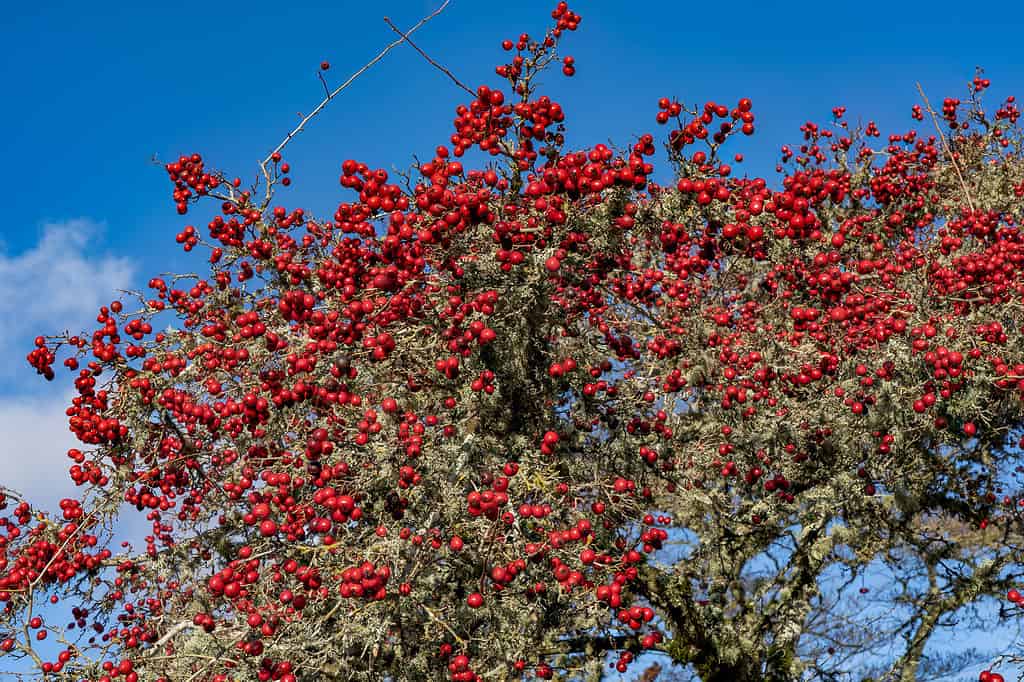
The crabapple grows in the wet soils and is very cold hardy.
©Bob Pool/Shutterstock.com
Crabapples are fruit trees that grow in Ohio, and they provide a colorful and fragrant addition to any yard. To get started, it’s important to choose a tree that is suited to Ohio’s hardiness zones and climate.
Some recommended crabapple cultivars for Ohio include:
- ‘Adirondack’ (zones 3-7)
- ‘Donald Wyman’ (zones 4-7)
- ‘Prairifire’ (zones 4-8)
- ‘Centurion’ (zones 4-7)
- ‘Sargent’ (zones 4-7)
To plant a crabapple tree, choose a spot with well-draining soil and full sun. Dig a hole that is twice as wide as the root ball and as deep as the root ball. Place the tree in the hole and backfill it with soil, making sure to cover the roots completely. Water the tree deeply, and spread a 3-inch layer of mulch around the base of the tree.
It’s important to water new crabapple trees regularly and avoid over-fertilizing. Prune the tree in late winter or early spring to encourage a strong, healthy form. With proper care, a crabapple tree can live for many years.
12. Pawpaw
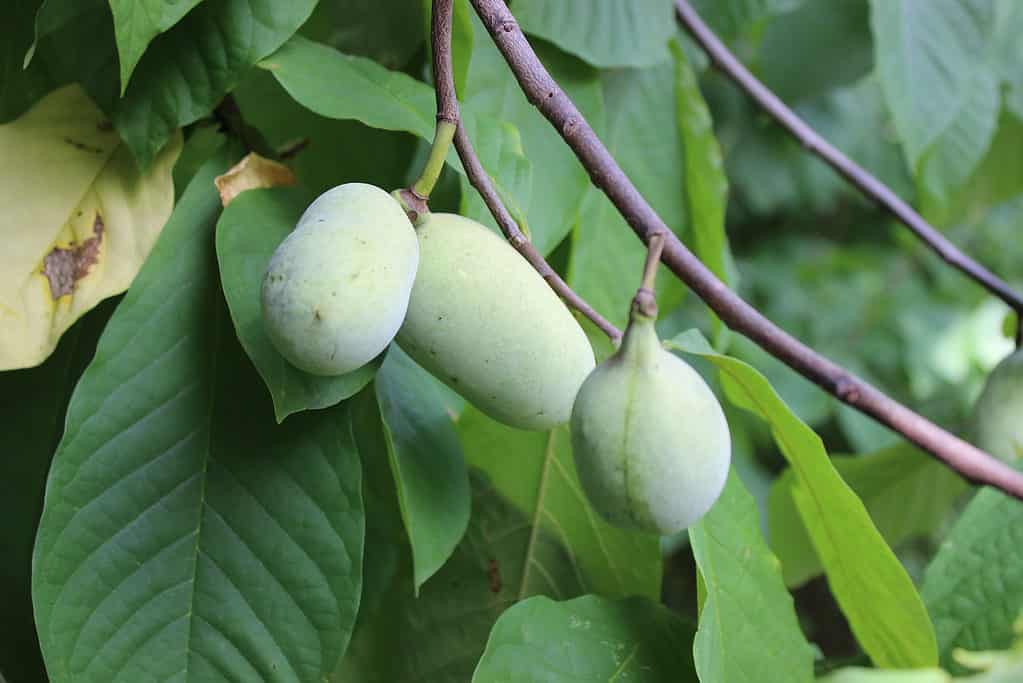
The American pawpaw tree grows in the eastern part of the United States and Canada.
©iStock.com/Jon Kraft
Pawpaw trees provide a unique flavor to Ohio gardens and can be grown in hardiness zones 5-9. The most popular cultivar for Ohio is the Davis Pawpaw, which grows in hardiness zones 5-7. This variety is a reliable producer of large, creamy-textured fruit with a sweet, tropical flavor. Other recommended cultivars for Ohio include Overleese, Taylor, Sunflower, and Potomac.
When growing pawpaw trees in Ohio, plant in a location that receives full sun and has well-drained soil. Planting in an area that is protected from strong winds is also beneficial.
Pawpaw trees require regular watering during the growing season, especially during periods of drought. Fertilization is not necessary, but mulching the soil around the tree can help retain moisture and protect the roots from extreme temperatures.
13. Kiwi

Did you know you can grow kiwis in Zone 5?
©iStock.com/YayaErnst
Kiwis are technically a berry and can thrive in Ohio, provided the right cultivar is selected. Gardeners in hardiness zones 5 and 6 should choose a cultivar suitable for cold winter temperatures. The following cultivars are hardy down to zone 5.
- Ananasnaya
- Geneva
- Pautske
- Arctic Beauty
- Dumbarton Oaks
The first step is to dig a hole twice as wide and twice as deep as the root ball. Amend the soil with compost and mulch, and add a balanced fertilizer. Plant the kiwi at the same level it was previously growing and fill it with soil.
Water the kiwi regularly, but avoid overwatering. Provide support for the vine-like branches, such as trellis or fences. Prune yearly to remove dead or weak branches and encourage new growth. In the fall, protect the tree with straw or other mulch. Wrap the trunk with a tree wrap to protect it from sunscald and rodent damage.
14. Chestnut

Horse
chestnuts also grow in Ohio.
©Brzostowska/Shutterstock.com
Growing chestnut trees in Ohio is possible with the right cultivars and conditions. Residents in hardiness zones 5 and 6 should select cultivars like Marrone, Mt. Etna, and Nanking.
Plant in well-drained, loamy soil in a sunny spot and water deeply once a week. To promote growth, fertilize with a slow-release fertilizer in the spring and fall. Prune chestnut trees in the winter to encourage branching and growth. Monitor for pests and diseases like borers and blight, and treat them accordingly.
15. Serviceberry

The flowers of serviceberry trees are a favorite with pollinators.
©Wirestock Creators/Shutterstock.com
Serviceberries are great fruit trees that grow in Ohio. They are easy to grow and can provide vibrant foliage and beautiful blooms in the spring. To successfully grow serviceberries in the Buckeye State, it is essential to choose the right cultivar for Ohio’s hardiness zones 5 and 6.
The most popular cultivar for Ohio is the Allegheny serviceberry, which has fragrant white flowers and withstands cold temperatures. For a more compact serviceberry tree, the Princeton Gold is a great option. This cultivar has a rounded shape and produces clusters of bright yellow flowers.
When planting serviceberry trees, be sure to choose a spot that gets plenty of sun and has well-drained soil. Carefully dig a hole that is twice as wide as the root ball, and then fill it with a mixture of soil and compost. Water regularly and prune in late winter to encourage a healthy shape.
16. Quince

Quince fruits are similar to pears and taste great when made into jam.
©darksoul72/Shutterstock.com
Growing quince trees in Ohio is easy and rewarding. Depending on your location in the state, you should select a cultivar that is hardy in Ohio hardiness zones 5 or 6. Some recommended cultivars include Champion, Smyrna, and Orange.
When planting, make sure to select a sunny spot with well-drained soil. Dig a hole twice the size of the root ball and add compost or other organic matter to the soil. Place the tree in the hole and fill the remaining space with soil. Water the tree thoroughly and spread mulch around the base.
You will need to prune quince trees annually to keep them healthy and promote flowering. In late winter or early spring, prune out diseased or dead wood and select a few branches to thin out. This will help keep the tree from becoming too dense.
Fertilize sparingly with a balanced fertilizer each spring. Quince trees are drought-tolerant once established, so you won’t have to worry about watering them. However, if the weather is especially dry, give them a drink deeply once a week.
17. Persimmon
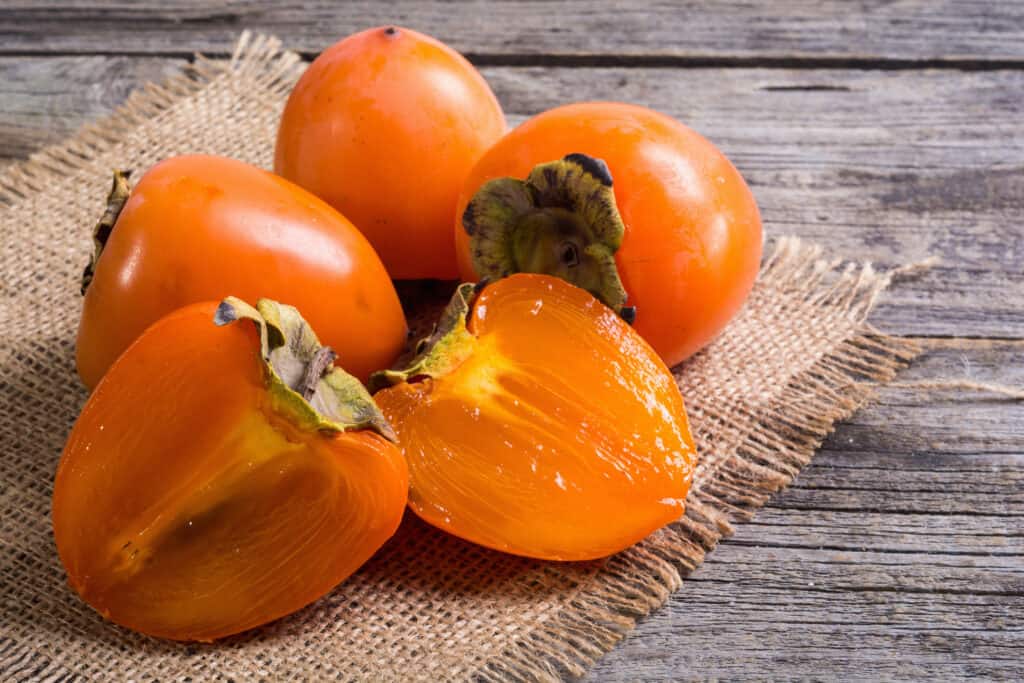
Delicious persimmons are fun to grow at home.
©AlexeiLogvinovich/Shutterstock.com
Ohio has a temperate climate, making it a great place for growing persimmon trees. To get started, choose the right cultivar. The persimmon cultivar ‘American’ is hardy down to zone 5.
When planting, choose a sunny spot with well-drained soil, and make sure the tree has plenty of room for growth. Dig a hole that is twice the width of the root ball and just as deep. Place the tree in the hole, and fill it with soil and water deeply. Mulch the tree to help retain moisture and discourage weeds. Prune the tree as needed and water regularly to keep the soil moist but not soggy.
18. Elderberry
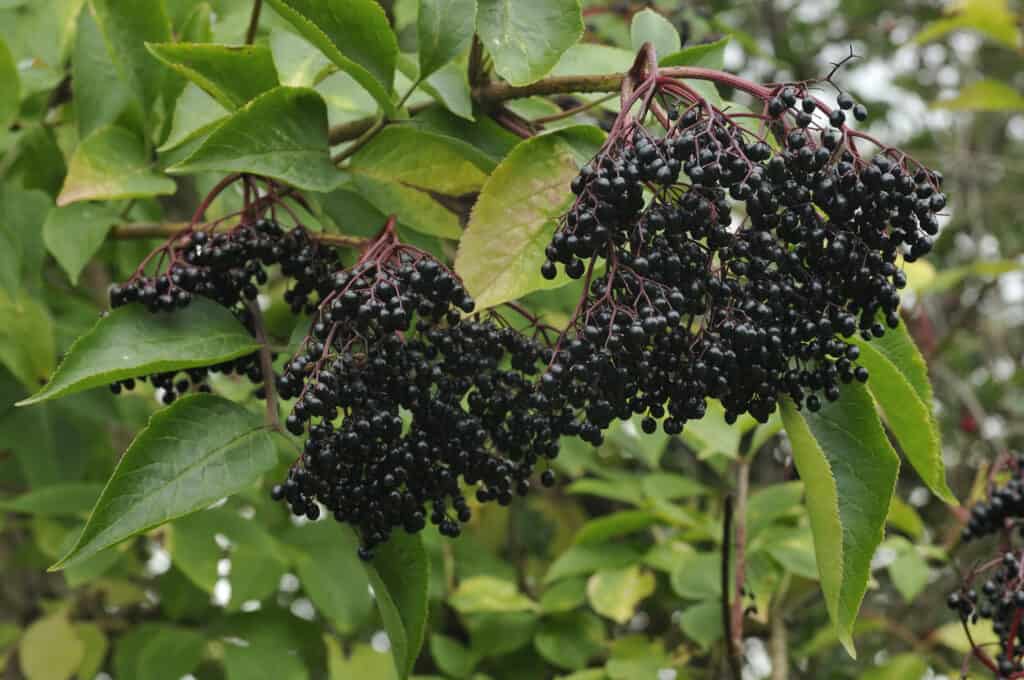
Black elderberry (Sambucus nigra) fruits grow in Ohio.
©Martin Fowler/Shutterstock.com
Elderberries are tasty and nutritious fruit trees that grow in Ohio. To ensure success, you’ll need to select a cultivar that is suitable for Ohio’s hardiness zones 5 and 6. Recommended varieties include Johns, York, Adams, Nova, and Black Lace.
When planting your elderberry bush, select a spot that receives full sun. Dig a hole that is twice as wide as the root ball and just as deep. Place the root ball in the hole and fill the hole with soil, making sure to tamp the soil down firmly. Water the soil around the bush.
Mulch the soil around the bush to help retain moisture. Keep the soil around the bush moist but not soggy. Prune the bush in the spring to promote new growth. You’ll need to protect your elderberry bush from birds and other pests. It’s also essential to water the bush regularly during dry weather.
Summary of 18 Fruit Trees That Grow In Ohio
| Number | Fruit |
|---|---|
| 1 | Apple |
| 2 | Apricot |
| 3 | Cherry |
| 4 | Peach |
| 5 | Pear |
| 6 | Plum |
| 7 | Nectarine |
| 8 | Fig |
| 9 | Mulberry |
| 10 | Walnut |
| 11 | Crabapple |
| 12 | Pawpaw |
| 13 | Kiwi |
| 14 | Chestnut |
| 15 | Serviceberry |
| 16 | Quince |
| 17 | Persimmon |
| 18 | Elderberry |
The photo featured at the top of this post is © Elena Sherengovskaya/Shutterstock.com
Thank you for reading! Have some feedback for us? Contact the AZ Animals editorial team.







